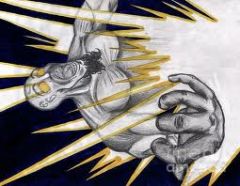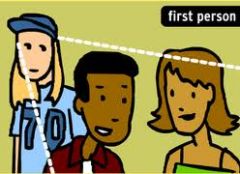![]()
![]()
![]()
Use LEFT and RIGHT arrow keys to navigate between flashcards;
Use UP and DOWN arrow keys to flip the card;
H to show hint;
A reads text to speech;
10 Cards in this Set
- Front
- Back
|
(Character) Meursault: Psychologically detached from the world around him, he does not lie, or feel emotions and is considered indifferent
|

This picture shows Meursaults emotional indifference
|
|
|
(Character) Raymond Sintes: Catalyst to "The Stranger’s" plot, can also be seen as a catalyst of Meursault’s “enlightenment" due to the way he brings about Meursault's realizition of indifference
|

This picture helps represent the enlightenment of Meursault and eventual conviction brought on by Sintes
|
|
|
(Symbolism) The Courtroom: Attempts to construct a logical explanation for Meursault’s crime which is like trying to find a rational answer to an irrational problem
|

|
|
|
(Symbolism) The Crucifix: Symbolizes rational belief structure, Meursault rejects Christianity which could be seen as rejecting rational order, branding him as a threat to a social order
|

|
|
|
(Theme) Universal Irrationality: The Universe is irrational, people make their own decisions based upon what they believe. If something is abstract or out of place it is irrational, like Meursault and his absence of emotion.
|

|
|
|
(Theme) Meaninglessness of Life: Birth, life, then death; through this Meursault shows that everything is born then grows until it dies for everything dies in the end. He does not realize this until the end, and in a way it help him achieve a sense of happiness for the remainder of his life
|

|
|
|
(Structure) POV: Meursault narrates the story in first person and limits his account to his own thoughts, he describes other characters without giving their thoughts or feeling
|

One person, reader can see only what the narrator sees and knows only the narrator's thoughts
|
|
|
(Setting) Algeria in the mid-1940s- The French had control where the story takes place. Since Meursault killed an Arab it was not that bad of a crime, his crime, since the area was in French control, was that of not obeying Christian and French customs.
|

|
|
|
(Irony) Thomas Perez, the one person who actually cares about Madame Meursault, cannot keep up with her funeral procession because of his physical condition, this is ironic because she is dead and he is alive.
|

|
|
|
(Irony) The story of the returning son murdered by his mother and sister is ironic because it, like the murder committed by Meursault, is an purposeless irrational tragedy.
|

|

